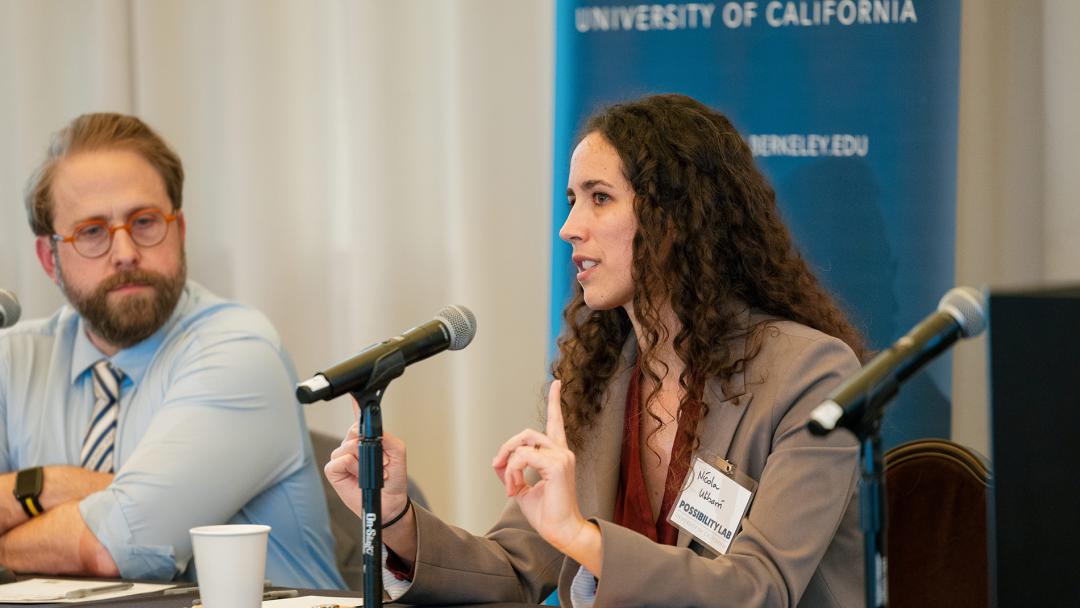
Nícola Ulibarrí, right, speaks at the UC Berkeley Possibility Lab’s Abundance Accelerator Summit.
Ulibarrí counters the California water narrative at Sacramento summit
Talking to an attentive crowd in Sacramento last month, Nícola Ulibarrí purposely countered a “dominant narrative” about water in the Golden State.
“For most Californians,” said the UC Irvine associate professor of urban planning and public policy, “we are in a state of relative abundance.”
Ulibarri’s bold statement is not what we’ve been told by politicians, the media and those political placards lining the 5 Freeway in Central California.
One of the state’s leading experts on water resource management, Ulibarrí spoke at the UC Berkeley Possibility Lab’s March 6 Abundance Accelerator Summit. The summit was held five months after she was tapped to join the UC Abundance Policy Research Consortium, a group of 12 experts from across California developing an evidence-based, fundamentals-first policy agenda for the state.
As the consortium’s water expert, Ulibarrí gave a brief talk to kick off “Sustaining Abundance: Ensuring Essential Resources for a Healthier Future,” which was the final of four panel presentations during the Sacramento summit.
“In terms of physical hydrology, water in California is less scarce than it is variable,” Ulibarri said as she walked over to a map that illustrated her point. It showed some desert and Central Valley spots that are “as dry as anywhere in the country” but also areas along the north coast of the Sierra-Nevada that “get as much precipitation as anywhere in the country. So, we have really both extremes.”
California’s “vast water infrastructure” stores water captured during wet years for distribution to the dry areas, said Ulibarrí, citing figures that show 95% of the state population and 90% of the economy are supported by just 20% of human water use.
Horror stories surround the other 5% of the population whenever there is a drought and wells dry up, she noted. Meanwhile, state law mandates that all residents are supposed to get enough water for drinking, bathing and cooking, but “there’s a lot of people for whom that is not true. We still have, by this law’s definition, almost 2 million Californians who are supplied by water utilities that are not meeting these basic needs,” Ulibarrí said.
The scholar ticked off ways to end this dilemma:
- The state could step in and require utilities to maintain enough domestic supplies to serve everyone in their districts;
- Funding and technical support could allow small water systems to consolidate and provide safe, clean, affordable water;
- Permitting could be eased to open new supplies of water through desalination, recycling and capturing and storing flood waters.
Ulibarri’s fellow panelists were Associate Professor Keith Taylor of the UC Davis Cooperative Extension & Community Economic Development and Professor Anastasia Telesetsky of the Cal Poly San Luis Obispo Department of Natural Resources and Environmental Sciences.
Telesetsky talked about how California is among the world’s largest producers of food and the Golden State’s progressive legislature stipulates that food is a basic human right. Yet, food insecurity remains a nagging problem, particularly among the elderly and disabled. She offered an Abundance Agenda to meet the challenge by:
- Making high-quality food—or that with minimal industrial preservatives and no pesticide residues—available at all stages of life;
- Providing access to a variety of health food options with adequate vitamins, minerals and micronutrients;
- Ensuring soil supports healthy ecological biodiversity;
- Thinking of food as a community builder through judgment-free sharing programs serving reduced- or no-cost meals.
Taylor spoke of how forward-thinking Californians, who “can see a clean, renewable, more equitable energy grid on the horizon,” can leverage that resource for more community wealth building. Complicating matters, he said, are state and federal policies that are less focused on “America’s revered small businesses” and more fixated “on legacy, investor-owned utilities whose hefty margins are protected and guaranteed under various state public utilities commissions.”
The UC Davis scholar recommended Californians look not to big business as usual but instead to the rural American South and Midwest of a century ago, when the public power movement was born not by taxpayer handouts, but low-interest loans paid back to taxpayers. “It’s a hidden economy of community-owned power,” Taylor said.
The three professors turned the microphone over to moderator Sean Kennedy, deputy director of energy investments at the Strategic Growth Council, who asked, given each expert’s policy area, if they heard anything on the panel that made them think about the food/energy/water nexus through an abundance frame.
Ulibarrí acknowledged the “big interconnections there” and being cognizant of how building abundance in one policy area could harm another policy area. By the same token, she said that more affordable or lower greenhouse gas emitting energy would help the overall efficiency of the water sector and that solving challenges with hydropower, seawater hydroponic growing and soil management practices could make crops more robust and resilient while using less fresh water.
Asked by Kennedy what she hopes people do after seeing her presentation, Ulibarri answered, “My ask is that we change the narrative around water abundance in California. If somebody says we are a dry state, you can say, ‘Actually, we’re not.’ But point a light on this 5% of California that doesn’t have enough water. … If we think that the problem is everywhere, then there is kind of no solutions to it. But if we have these targeted [areas], like these households that are missing water, then it makes it a much easier problem to solve.”
You can watch the full “Sustaining Abundance” panel presentation on the Possibility Lab website or on YouTube:
The entire Abundance Accelerator Summit is available online.
— Matt Coker